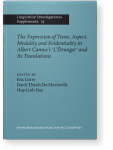Chapter 8
The PC and Imparfait in German and Swedish (re)translations of L’Étranger
This comparative study investigates the
strategies used for translating the French past tenses
(passé composé and imparfait)
in two Swedish and two German translations of Camus’
L’Étranger. Due to grammatical restrictions of
the target languages, it is difficult for a translator to render
both the semantics and the stylistic effects connected to these
French past tenses. The first translation into Swedish and the first
translation into German both conform to target culture norms as they
use präterium (German) and
preteritum and aspectual verbal markers
(Swedish). The retranslations into both languages reproduce, to a
much higher degree, the restrained style of the original, either
through the alternation between präteritum and
perfekt (German) or a less frequent use of
verbal markers (Swedish).
Article outline
- 1.Introduction
- 2.Aspect in the past tenses of French, German, and Swedish
- 3.The retranslation hypothesis
- 4.Material: Four translations of L’Étranger
- 5.The empirical study
- 5.1Tense
- 5.2Verbal markers that are relevant to aspect
- 6.Summary and concluding remarks
-
Notes
-
References
